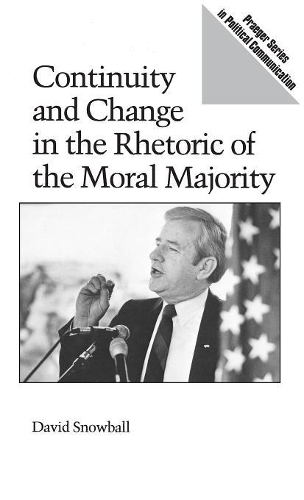
Continuity and Change in the Rhetoric of the Moral Majority
(Hardback)
Publishing Details
Continuity and Change in the Rhetoric of the Moral Majority
By (Author) W David Snowball
Bloomsbury Publishing PLC
Praeger Publishers Inc
30th March 1991
United States
Classifications
Tertiary Education
Non Fiction
322.440973
Physical Properties
Hardback
200
Description
The persuasive strategies employed by the Moral Majority in the early 1980s reassured and calmed a segment of the American population left confused and uncertain by recent national events. David Snowball analyzes this powerful movement, how its rhetoric energized its supporters, the positions it endorsed and causes it championed, and its response to political and media critics. By examining the fundamental messages, the tactics used, and the personalities involved, the study reveals that, while the basic message of the Moral Majority remained constant, its changing popular image and maturing rhetoric, which initially added momentum to its rapid rise, may also have been at the root of its swift decline by the end of the decade. While tracing the movement's origins, Snowball investigates in-depth the American people's reaction to the influence of the Moral Majority. He subsequently reviews its founding tenets and the language typically used to encourage its disciples. A look at the specific issues which polarized critics and followers exposes the reasons for the movement's collapse and poses questions regarding its future. Although the primary focus of this study is the history of the Moral Majority, the analysis also provides valuable insight into the nature of the American political system's response to religiously-motivated movements in general.
Reviews
This tightly organized volume analyzes the rhetorical efforts of the Moral Majority by describing and interpreting its messages and strategies. The major source utilized in the study was the monthly Moral Majority Report. The central question explored: How did the rhetoric of the Moral Majority change over time One thesis advanced is that the organization changed its presentation, not the substance of its arguments over time. Snowball carefully chronicles the history of the organization, considering 1979-1981 as years of mobilization and legitimation and 1982-1985 as a period characterized by the evolving agenda of Christianity, abortion, and pornography. The book concludes with an assessment of the Moral Majority and thoughts on the reasons for its demise. Overall, this is a thorough study. Rhetorical scholars will be especially interested in the thoughtful chapter on metaphor--specifically the Moral Majority's use of the war metaphor. This chapter alone makes the book significant. But the remainder of the text is equally rewarding. A fair index and excellent bibliography. Thorough documentation throughout. Highly recommended.-Choice
"This tightly organized volume analyzes the rhetorical efforts of the Moral Majority by describing and interpreting its messages and strategies. The major source utilized in the study was the monthly Moral Majority Report. The central question explored: How did the rhetoric of the Moral Majority change over time One thesis advanced is that the organization changed its presentation, not the substance of its arguments over time. Snowball carefully chronicles the history of the organization, considering 1979-1981 as years of mobilization and legitimation and 1982-1985 as a period characterized by the evolving agenda of Christianity, abortion, and pornography. The book concludes with an assessment of the Moral Majority and thoughts on the reasons for its demise. Overall, this is a thorough study. Rhetorical scholars will be especially interested in the thoughtful chapter on metaphor--specifically the Moral Majority's use of the war metaphor. This chapter alone makes the book significant. But the remainder of the text is equally rewarding. A fair index and excellent bibliography. Thorough documentation throughout. Highly recommended."-Choice
Author Bio
DAVID SNOWBALL is Assistant Professor in the Department of Speech Communication at Augustana College.
